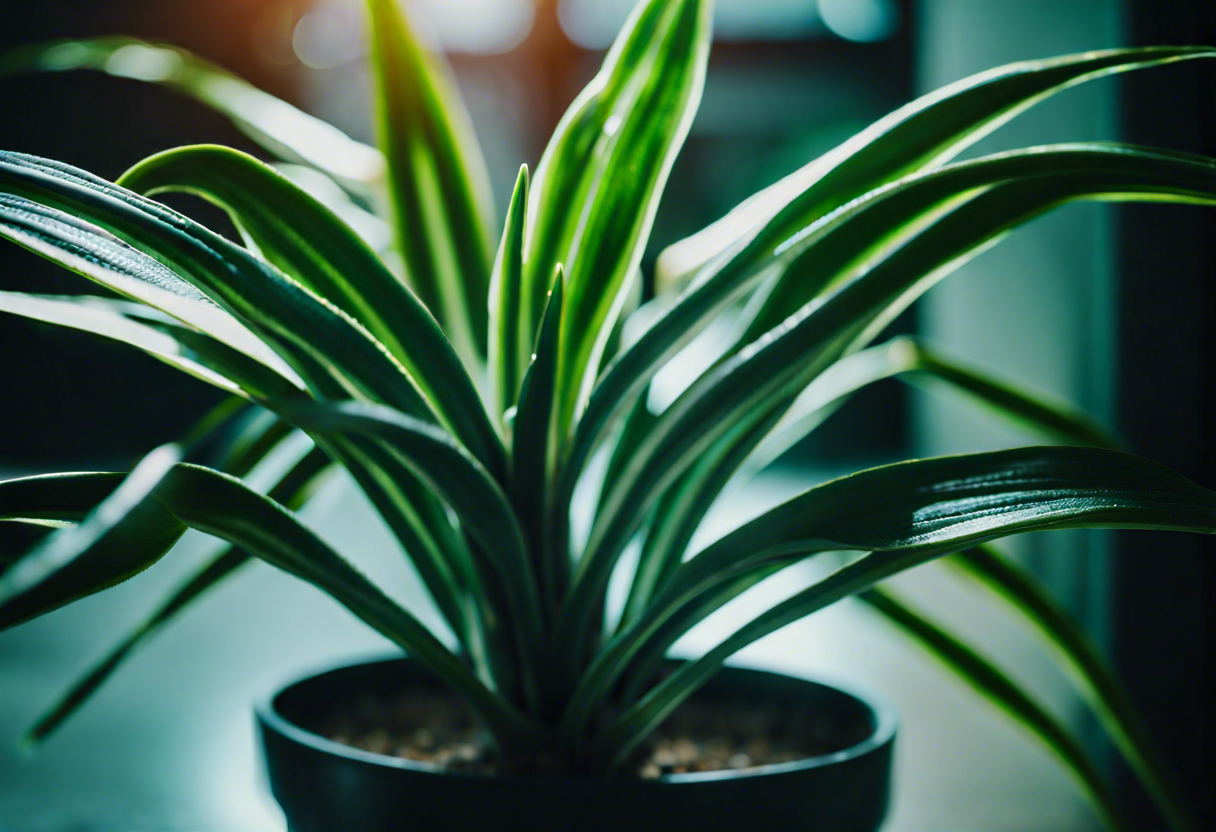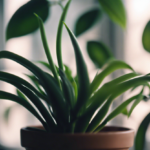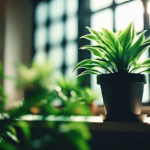Watering and Humidity Requirements for Dracaena Plants:
Dracaena plants are popular houseplants known for their striking foliage and low maintenance requirements. To keep your Dracaena healthy and thriving, it’s essential to understand their watering and humidity needs. Proper watering is crucial as both overwatering and underwatering can lead to the decline of your plant.
When it comes to watering, it’s important to strike a balance. Dracaena plants prefer slightly moist soil but are prone to root rot if left in soggy conditions. A good rule of thumb is to water your Dracaena when the top inch of the soil feels dry to the touch. Avoid letting the plant sit in standing water, as this can lead to waterlogged roots.
During the growing season, typically spring and summer, you’ll need to water your Dracaena more frequently. As the temperature rises, the plant’s water requirements increase. However, during the dormant period in winter, you should reduce watering to once every two weeks or when the soil becomes dry.
Humidity is another aspect of Dracaena care that you should consider. While these plants can tolerate average indoor humidity levels, they appreciate slightly higher humidity. You can increase humidity by placing a tray of water near the plant or using a humidifier. Misting the leaves occasionally can also help to mimic the natural humidity levels found in their native tropical environments.
It’s important to note that different Dracaena varieties may have slightly different watering and humidity preferences. For example, Dracaena marginata tolerates drier conditions compared to a Dracaena fragrans ‘Massangeana’ variety, which prefers more regular watering. Always observe your plant’s response to watering and adjust accordingly.
proper watering and humidity play a significant role in the care of Dracaena plants. Remember to strike a balance, providing enough moisture to keep the soil slightly moist without letting the plant sit in standing water. Additionally, consider increasing humidity levels to promote healthy growth. By following these guidelines, you can ensure your Dracaena thrives and becomes a stunning addition to your indoor space.
Optimal Lighting Conditions for Dracaena Care
What are the Optimal Lighting Conditions for Dracaena Care?
When it comes to caring for Dracaena plants, providing them with the right amount of light is crucial for their overall health and growth. Dracaena plants are known for their ability to thrive in various lighting conditions, but understanding their optimal lighting requirements can make a significant difference in their overall well-being.
Indoor Lighting: Dracaena plants are popular choices for indoor spaces due to their ability to adapt to lower light conditions. They can tolerate moderate to low light levels, making them suitable for areas such as offices or rooms with limited natural light. It is best to place them near a north or east-facing window, where they can still receive indirect but bright light. Avoid placing them in direct sunlight, as it can scorch their leaves. If the lighting in your indoor space is particularly low, you can supplement it with artificial lighting using fluorescent or LED grow lights.
Outdoor Lighting: If you are growing Dracaena plants outdoors, it is important to provide them with the optimal lighting conditions. They thrive in partial shade or filtered sunlight, as direct sunlight can lead to leaf burn. Morning or late afternoon sun is ideal for outdoor Dracaena plants, as it is less intense. If you live in a region with hot and intense sunlight, it is recommended to provide some shade during the hottest part of the day to prevent leaf damage.
Signs of Inadequate Lighting: It is crucial to observe your Dracaena plant for signs of inadequate lighting, as it can affect their growth and overall health. If they are not receiving enough light, they may exhibit certain symptoms, such as pale or yellowing leaves, leggy growth, or a general lack of vitality. On the other hand, if they are exposed to too much direct sunlight, their leaves may develop brown spots or show signs of scorching.
Tips for Optimal Lighting: To ensure optimal lighting conditions for your Dracaena plants, consider the following tips:
- Rotate your indoor Dracaena plant periodically to ensure even light distribution on all sides.
- Keep an eye on the intensity of the light your plant receives and provide shade if necessary.
- If you notice signs of inadequate lighting, gradually increase the light exposure rather than transitioning them abruptly.
- Monitor your plant’s response to the lighting conditions and make adjustments accordingly.
By providing the optimal lighting conditions for your Dracaena plants, you can help them thrive and maintain their vibrant foliage. Remember to strike a balance between light exposure and protection to ensure their overall well-being.
The Right Soil and Potting Mix for Dracaena Plants
Dracaena plants, also known as dragon trees, are popular houseplants cherished for their unique foliage and easy care requirements. To ensure their optimal growth and overall health, it is essential to choose the right soil and potting mix. In this guide, you will learn about the ideal soil composition and the importance of proper drainage for dracaena plants.
When it comes to soil, dracaena plants thrive in a well-draining mix that allows excess water to escape easily. A combination of peat moss, perlite, and coarse sand is generally recommended. Peat moss retains moisture while providing adequate aeration, perlite helps with drainage, and coarse sand ensures the soil doesn’t become compacted. This mix allows the roots to breathe and prevents the risk of root rot.
To create the perfect potting mix, you can combine equal parts peat moss, perlite, and coarse sand in a container. Mix them thoroughly until you achieve a homogeneous texture. Alternatively, you can also find pre-packaged potting mixes specially formulated for tropical plants like dracaena.
Choosing the right pot is equally important for dracaena care. Opt for a pot with drainage holes at the bottom to facilitate water runoff. Avoid using pots without drainage, as stagnant water can lead to root rot and other moisture-related problems. Additionally, select a pot that allows for some room for the plant’s roots to grow. This will prevent the roots from becoming cramped and promote healthy development.
When repotting dracaena plants, it’s crucial to carefully remove the plant from its current pot without disturbing the roots too much. Gently loosen the outer soil before transferring it to the new pot, and fill the remaining space with the fresh potting mix. After repotting, lightly tamp down the soil to ensure the plant is firmly rooted.
Dracaena plants prefer slightly acidic to neutral soil with a pH range between 6 and 7. Regularly assess the moisture level of the potting mix by inserting your finger a few inches into the soil. If it feels dry, it is time to water your dracaena. However, if the soil feels moist, allowing it to dry out a bit before watering is essential to avoid overwatering.
Choosing the right soil and potting mix for your dracaena plants is vital for their overall well-being. A well-draining mix that promotes aeration and prevents waterlogged roots is crucial. By adhering to these guidelines, you can create a suitable environment for your dracaena to thrive, ensuring long-lasting beauty in your indoor space.
Dracaena Pruning and Propagation for Healthy Growth
When it comes to the care and maintenance of Dracaena plants, pruning and propagation play crucial roles in promoting healthy growth and vitality. Pruning helps to maintain a neat and tidy appearance while also encouraging new growth. Propagation, on the other hand, allows you to expand your collection or share your plant with others. Here are some important tips and techniques for pruning and propagating Dracaena plants.
Pruning Dracaena Plants:
To start pruning your Dracaena plant, you will need a pair of clean, sharp pruning shears or scissors. Begin by inspecting the plant for any dead, yellowing, or damaged foliage. Using your pruning shears, make clean cuts just above the point where the leaf or stem attaches to the main stalk. This will encourage new growth and prevent the spread of any diseases or pests.
In addition to removing unhealthy foliage, you may also want to shape the plant for aesthetic purposes. Trim back any overgrown or unruly branches to create a more balanced and pleasing appearance. Remember to prune sparingly to avoid stressing the plant.
Propagating Dracaena Plants:
Propagating Dracaena plants can be done through stem cuttings. Start by selecting a healthy stem with multiple leaves on it. Using a clean, sharp knife, cut the stem just below a leaf node, which is where the leaf attaches to the stem. Make sure the cutting is at least 4-6 inches long.
Next, remove the lower leaves from the cutting, leaving only a few at the top. Dip the cut end of the stem in rooting hormone, if desired, to promote faster root development. Plant the cutting in a well-draining potting mix, ensuring that at least one node is buried in the soil. Keep the soil lightly moist and place the cutting in a warm, bright location away from direct sunlight.
Within a few weeks, roots should start to develop, indicating that the cutting has successfully rooted. At this point, you can gradually acclimate the new plant to brighter light and normal watering routines. With proper care, the new Dracaena plant will continue to grow and thrive.
Pruning and propagating Dracaena plants are essential tasks that help promote their overall health and appearance. Through regular pruning, you can remove any diseased or damaged foliage, as well as shape the plant for a more attractive appearance. Propagation allows you to grow new plants from existing ones, giving you the opportunity to expand your collection or share with others. By following the proper techniques, you can ensure the successful growth and longevity of your Dracaena plants.
Common Pests and Diseases Affecting Dracaena Plants and How to Prevent Them
Dracaena plants are known for their resilience and ability to thrive in a variety of indoor settings. However, like any other plant, they are not immune to pests and diseases. In this section, we will discuss some of the common issues that can affect Dracaena plants and provide tips on how to prevent them.
One of the most common pests that can target Dracaena plants is the spider mite. These tiny arachnids feed on the sap of the plant, causing yellowing leaves, webbing, and overall decline in the plant’s health. To prevent spider mite infestation, regularly inspect your Dracaena plants. If you notice any signs of webbing or damage, isolate the affected plant and treat it with an insecticidal soap or neem oil spray. Additionally, frequently misting your Dracaena plants can help increase humidity and deter spider mites.
Another pesky pest that can cause harm to your Dracaena plants is the mealybug. These soft-bodied insects feed on the plant’s sap and can be found on the foliage, stems, and leaf axils. Mealybugs are known for their cotton-like appearance and can cause stunted growth, leaf yellowing, and leaf drop. To prevent mealybug infestation, regularly inspect your plants and remove any visible bugs manually using a cotton swab dipped in rubbing alcohol. You can also use insecticidal soap or neem oil spray to treat the affected plants.
Fungal diseases can also pose a threat to Dracaena plants, especially when the conditions are too damp or humid. Root rot is a common fungal disease that affects the roots, leading to yellowing leaves, wilting, and root decay. To prevent root rot, avoid overwatering your Dracaena plants and ensure proper drainage by using well-draining soil and pots with drainage holes. If you notice signs of root rot, it is crucial to take immediate action by removing the affected roots and repotting your plant in fresh, dry soil.
Leaf spot is another fungal disease that can affect Dracaena plants, causing dark or water-soaked spots on the leaves. This disease is commonly caused by overwatering, high humidity, or poor air circulation. To prevent leaf spot, avoid wetting the foliage when watering your plants and ensure good airflow around the plant by providing adequate spacing between them. If leaf spot is already present, remove the affected leaves and improve the growing conditions to prevent further spread.
While Dracaena plants are generally hardy, they are still susceptible to pests and diseases. By regularly inspecting your plants, maintaining proper watering and humidity levels, and providing good airflow, you can prevent common issues such as spider mites, mealybugs, root rot, and leaf spot. Remember to address any problems promptly to ensure the health and vitality of your Dracaena plants.
Conclusion
Taking care of Dracaena plants involves understanding and meeting their specific needs. Watering is a crucial aspect of Dracaena care, and it is important to provide them with adequate moisture while avoiding overwatering. Regularly checking the soil’s moisture level and adjusting water frequency accordingly is key to maintaining healthy Dracaena plants. Similarly, providing the right humidity levels by misting the leaves or placing the plants on trays filled with water and pebbles can contribute to their overall well-being.
Dracaena plants thrive in optimal lighting conditions, and it is essential to consider their light requirements when choosing a suitable spot for them. These plants prefer bright, indirect light and can tolerate some shade. Care should be taken to avoid exposing them to direct sunlight for prolonged periods, as it can cause damage to their leaves. A balance must be struck to ensure they receive enough light to promote growth without risking sunburn or leaf discoloration.
Choosing the right soil and potting mix is crucial for the successful growth of Dracaena plants. Well-draining soil with a slightly acidic to neutral pH is recommended. A mix of peat moss, perlite, and sand provides ideal drainage and aeration, preventing waterlogged roots. Additionally, selecting a pot with drainage holes allows excess water to escape, reducing the risk of root rot and other water-related issues.
Pruning and propagating Dracaena plants are essential practices for maintaining their health and promoting vigorous growth. Regular pruning helps remove dead or yellowing leaves, improving the plant’s aesthetics and overall appearance. Propagation can be done through stem cuttings or air layering, allowing you to expand your Dracaena collection or replace old plants. These methods require proper technique and care to ensure successful propagation.
Pests and diseases can pose a threat to Dracaena plants, but with preventive measures, these issues can be minimized. Common pests that affect Dracaena include spider mites, mealybugs, and scale insects. Regularly inspecting the plant for signs of infestation and treating with organic insecticides or neem oil can help control these pests. Proper ventilation and avoiding overwatering can prevent fungal diseases such as root rot and leaf spot.
By following these care guidelines, you can ensure the longevity and vitality of your Dracaena plants. Understanding their watering and humidity requirements, providing them with optimal lighting conditions, using the right soil and potting mix, and practicing proper pruning and propagation techniques will foster healthy growth. Additionally, staying vigilant against pests and diseases and taking preventive measures will help maintain the plants’ well-being. With a little care and attention, your Dracaena plants will continue to thrive and add beauty to your indoor or outdoor spaces.


